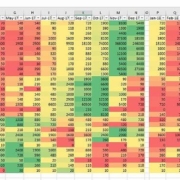What the data suggests for marketers facing COVID-19 uncertainty
If there is anything certain about COVID-19 is that it has created a high degree of uncertainty. And while we can’t predict when things will go back to normal, marketers and brands can look to data to inform some of their decisions on how to weather the storm.
As a data-driven content marketing firm, we look at models, research and surveys, first-party site analytics and social media conversation changes in order to keep our finger on the pulse of our client audiences.
In our work over the last few weeks, a couple of data points have emerged around how audience expectations are changing and how sentiment is being affected so we thought we would share what we are seeing.
#1: We can learn from what has happened in China
Gartner took an interesting approach with some of its research by looking at how behaviour has changed in China and providing recommendations on what the West can learn from it.
Some key takeaways:
- Internet usage is up dramatically, and so is customer expectations of digital platforms and online response times.
- Companies need to think about brand equity through cause marketing while balancing sales messaging.
- It’s now more important than ever to listen to customers and map changes from typical behaviour.
- Consider lighthearted, uplifting or informative content.
- Marketers must support customers and protect customer relationships while staying honest about what the firm can and cannot deliver at this time.
We’ve seen a lot of commentary around the move away from heavy sales messaging to human-to-human conversation and Gartner’s recommendations echo that.
And as Gartner also suggests, there is a need to monitor change and do it regularly.
The speed at which change is happening has our attention, as a brand that relies on conventional approaches to data review, analytics and benchmarking may put them at risk of being outdated before they have a chance to respond.
#2: Trust is the new KPI
As Forrester found, behaviour and sentiment are also changing. What historically may have taken several quarters (or more) to see changes now looks to have happened in a matter of weeks.
Some key takeaways:
- Trust has seen a dramatic drop and consumers are finding it hard to believe organizations “will do the right thing” or follow through on promises.
- Insular lifestyles are changing content consumption and consumers have a growing appetite for entertainment and learning to fill the void versus retreating to familiar actions they would normally undertake.
- Consumers feel like they are losing control of their circumstances.
With general sentiment down, we see the need to move marketing and communications messaging to trust-building efforts.
If trust is the KPI, efforts that feed the long-term are likely to deliver a stronger ROI than focusing on short-term.
#3: Audiences are not just falling back on the familiar
The other finding that has our attention is the fact insular lifestyles are stimulating audience appetite for information, content and entertainment. As a result, organizations may now have an opportunity to tell a different story, or look to distribute to new channels, and be heard in ways they previously couldn’t.
While there may be reason to pull back on some areas of paid for the short-term, SEO rankings driven by content marketing efforts are a long game. Search demand will fluctuate, but once it returns to normal levels, a brand risks being further down in the rankings than before COVID-19 hit by pulling back.
As Search Engine Land recommends, right now it’s vital to maintain — if not grow — SEO and content marketing programs.
Takeaways:
- Focus on being purpose-driven and deliver cause messaging
- Think about continuous content production in order to deliver relevant content to your audience, including feeding social media platforms with organic content daily
- Measure and listen to audience conversations on a regular basis to monitor for change
- Focus on earning trust as your KPI
We’d love to know how your marketing plans are changing as a result of COVID-19. What do you know about your audiences? How are you adjusting?
Let us know on Twitter at @djournalgroup, on LinkedIn here, or drop us a line.











